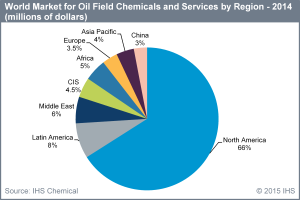IHS: $25 billion oilfield chemicals market expected to fall through 2019

Driven in large part by the rapid expansion of shale oil and gas drilling and production in North America, the world market for oilfield specialty chemicals at the service company level reached $25 billion in 2014. That’s up from nearly $16 billion in 2010. However, significant declines in oil prices have dampened the demand outlook for oilfield chemicals for the 2015 to 2019 period, according to a new global market study from IHS.
“The IHS Chemical 2015 Specialty Chemicals Update Report – Oilfield Chemicals” projects sales of oilfield chemicals will grow annually at a rate of approximately 4% to more than $30 billion in 2019, based on volume growth and price changes in effect at the end of 2014.
“During the past five years, we saw unprecedented market growth for oilfield chemicals, which has been driven by the rapid development and production of shale oil and gas resources in North America,” said Stefan Schlag, Director of Inorganic Chemicals and Mineral and Mining Products at IHS Chemical and lead author of the report. “We expect demand for these chemicals to continue to grow but at a much slower rate than in the previous period.”
IHS doesn’t expect lower oil prices to have a major impact on sales of chemicals to the production segment. However, “we expect lower prices will likely have more of an impact on sales of chemicals for drilling, stimulation and completion activities,” Mr Schlag said. “The primary reason for this is that actual oil production volumes are expected to continue to increase – in line with expected continued growth of world crude oil demand. However, lower crude oil prices have slowed exploration drilling and the drilling of new boreholes, especially for more complex unconventional and deepwater oil projects. These projects typically have higher production costs and are, in many cases, not economic at current oil prices.”
Despite the year-end slowdown in E&P activity driven by the oil price slide, hydraulic fracturing continued globally in 2014, but primarily in North America. In 2014, total chemical consumption related to fracturing was valued at nearly $8.6 billion. The US and Canada accounted for the lion’s share of demand at $8 billion, or approximately 94% of total world consumption of stimulant chemicals.
Latin America was a distant second in terms of demand for oilfield chemicals, accounting for slightly less than 9% of global demand or $2.2 billion of sales. The Middle East followed, with 8% of global oilfield chemical demand or $2 billion in sales. The CIS followed, with 6.5% of global demand for these chemicals or $1.6 billion in sales.
“It may seem counterintuitive, but markets for oil production chemicals show almost no correlation with regional, raw oil production volumes. In fact, rather than production volumes, it is the complexity of the oil production process itself – conventional, deep water or unconventional – that has a large impact on the demand for oilfield chemicals,” Mr Schlag said.
Despite the expected near-term market volatility for specialty chemicals, the oilfield services sector saw significant merger and acquisition activity at the end of 2014, with Halliburton announcing the largest deal – a $35 billion acquisition of Baker Hughes in November. That deal is expected to close in the second half of 2015, pending US government approval.
Prior to the acquisition announcement, Schlumberger led the oil field services sector, including oilfield chemicals sales, with total 2014 sales exceeding $48 billion, or more than 46% of the total oilfield services market. That was followed by Halliburton at slightly more than $32 billion in sales in 2014, or nearly 31% of market share. Baker Hughes followed in third position at nearly $24 billion in 2014 sales, or almost 23% of the market. Based on 2014 market share figures, a combined Halliburton and Baker Hughes would dominate the oilfield services market with slightly less than 54% of global market share.




